I didn’t have much good to say about my first visit to the Philippines. That time I confined my sojourn to the Manila and surrounds; this try I’ll try some of the other islands.
Delta brings me to Manila -- as dirty, ugly, congested, but even more overpriced than I remember -- where I meet up with Lorne for our annual December jaunt. We don’t stray far from the airport since we are flying out in the morning.
Island-hopping is easy and cheap thanks to Cebu Pacific, a low-cost carrier of the type I wish we had here. On the offhand recommendation of the bank clerk who handled a money transfer for me, our first destination is Iloilo (pronounced eelo-eelo), on Panay in the Western Viscayas. (The 7000+ islands that comprise the Philippine archipelago are divided into three major groups.)
| What do we find? Not a lot. Wikipedia describes Iloilo as “a highly-urbanized city.” On checking in to our hotel, we are greeted by this sign: |  |
On the assumption that criminals are unlikely to follow its directive, I assume that this admonishment is directed to overenthusiastic celebrants. During our stay the venue hosts a large gala and several weddings, but I don’t hear any gunfire.
 |
 |
| here to assist you | I'll bet two dozing Cholos on #5 |
Iloilo City has seen better days, and the lack of redevelopment has left a stock of art deco buildings to admire.


Directly across the Iloilo Strait and just a few minutes away by ferry lies the island of Guimeras.
 |
| the view from the ferry departing for Guimeras |


On to Cebu, “the second city of the Philippines” and the oldest. Magellan landed here in 1521. (He never left; he was killed in battle three weeks later.) The city’s most famous landmark is the cross he reputedly planted, now housed in a chapel next to the very large church of similar vintage.


|
|
|
 |
 |
 |
|
Our next flight takes us to Bacolod. It’s actually just across the Guimaras Strait from Iloilo and reachable from there by hourly ferry, but we are making up our itinerary on the fly and efficiency can only be measured in hindsight. Negros island was the home to wealthy sugar planters. Although prosperity is mostly a thing of the past, it is still considered a pleasant place to live. The city is home to the amusingly named Negros Museum (contrary to expectation, inhabitants are called Negrenses), housed in an impressive building but almost exhibit-free. |
|
|
If you want to see stuff on display, you need to head over to the Dizon Ramos Museum. Scion of a wealthy family, D-R's fairly modest postwar home is crammed with kitsch. (Next door is the half-abandoned, half-commercial prewar mansion which was occupied by the Japanese during WWII and never restored to residential use.) Downstairs you start on the keychain and Barbie Doll collections, before moving upstairs to rooms full of Hummel figures, Elmos, and plastic Santas. Smaller cases display smaller collections of matchbook covers and other tasteless tchotchkes. If someone told you that there was actually a museum of this junk, you wouldn’t believe it. The amazing thing is that the museum is regularly visited by school groups.
 |
|
 |
 |
Nearby Silay is the home to a number of large homes and former mansions. Most are wooden and now dilapidated, although a couple have restored interiors and are open to visitors. One is home to a truly magnificent collection of Barbie dolls dressed as historical figures, including Ken as MacArthur and B&K as Ferdinand and Imelda Marcos, complete with shoes.
 |
 |
 |
By far the most impressive is The Ruins, self-dubbed as “the Taj Mahal of Negros.” It is the remains of a truly magnificent mansion (“one of the 12 most fascinating ruins of the world”) torched by American guerillas to prevent it from being occupied by the Japs after we surrendered at Bataan. It took three days to burn. (If it had been the Japs that burned it, there would be no end to the bellyaching.) It’s now a popular wedding venue, and while we are there a photo shoot is in progress.


The featured attraction is a boat ride on the underground river, a series of limestone caverns in a national park two hours distant. Our attempt to contribute our patronage illustrates the ineptness that characterizes the entire country. Entry is by timed reservation only, yet the park doesn’t open until mid-morning, closes early, and takes a long lunch. We can’t book for tomorrow or the day after because it’s sold out. One government agency is charged with promoting tourism and another actively works to prevent it. Welcome to the Philippines, where the unofficial national motto is "Incompetence With a Smile."
We hire someone to drive us around for the day. Topping of our list is Palawan Prison, a huge penal farm that welcomes visitors. Color-coded T-shirts identify the security level of the inmates: minimum security prisoners (yellow) are fairly free to roam; mediums (green) are marched around under armed guard; and maximums (orange) don’t get out at all. You may have seen the video of hundreds of prisoners dancing to Thriller – that was done in Cebu; here we are treated to a private rendition of Gagnam Style.
 |
 |
 |
On the way back we visit the crocodile farm.
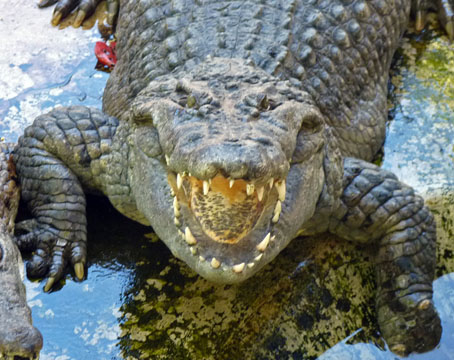
During the Japanese occupation the old Spanish fort was the site of the infamous Palawan Massacre: in December 1944 about 150 American survivors from the Bataan Death March were burned alive to prevent them from being liberated by the advancing American forces. The event precipitated raids on POW camps across the Pacific to prevent a recurrence. The Japs responsible were tried as war criminals and sentenced to death, but later released as part of a general amnesty.
The next day is a day of swimming and snorkeling, island hopping in Honda Bay. This is what the tourist board wants you to think of when you think Philippines.

Well, enough touristic trailblazing; the second part of this December trip is a return to the beaten path. Just two years ago I was in Vietnam for the third time, but the living is comfortable, easy, and cheap, and the food is good.
A direct flight from Manila lands me in Hanoi late at night, where I find the hotel I reserved closed. No worry, this is the tourist district and another similar hostelry is right next door. After a delicious breakfast (in the Philippines, one is lucky to encounter even one type for fruit at the breakfast buffet) I have the day to kill before Linda arrives tonight.
|
|
|
|
| I'm always keeping an eye out for art deco relics | or maybe a wedding |
One thing I do is cruise shopping. As I learned on my previous two trips there, December is not the best weather for visiting Ha Long Bay, but it's still a nice excursion. There are many, many boats and operators, each with an attractive brochure, and a zillion travel agencies. I finally select one at what seems to be a favorable price for a two night luxury cruise.
Having fetched Linda, we spend the day walking around. Old news to me, but a first for her. The city is festooned with banners, posters, and displays marking the 40th anniversary of the 1972 bombing campaign in which around-the-clock raid by B-52s and the mining of Haiphong harbor forced North Vietnam back to the negotiating table and led to the end of the American phase of the war. Except here it is celebrated as a great victory, the “Dien Ben Phu of the Air.” I realize that I was first here exactly fifteen years ago when the 25th anniversary was commemorated. Except back then it was not ancient history and people cared: two-thirds of the population was born since “reunification” (i.e., conquest of the South by the North). It is now clear who won: apart from the corrupt mafia government which hides behind a veneer of communist ideology, capitalism rules and the people want to be like us; the hoardings are an ossified regime’s claim to legitimacy.
 |
|
 |
 |
The fruits of the supposedly-defeated ideology have permitted the preservation of many handsome French colonial-era buildings, often now repurposed as embassies. The commie stuff is still around, but Lenin is looking lonely and the pickled-in-glass Ho Chi Minh has very limited visiting hours.
|
|
|
|
For the Ha Long Bay trip we are supposed to get picked up at our hotel. Van after van bearing the names of various tour companies come by, but not for us. Finally, after everyone else waiting has gone, a lone guy shows up. He takes us in a taxi to an aged bus full of backpackers and Vietnamese tourists. Not a good sign, but I figure a budget transfer is part of the deal.
The road to the coast has improved but the traffic makes up for it, so the ride still takes three hours. When we arrive, we are escorted to a decrepit scow. Based on past experience, I thought it was merely a transfer vessel to the boat I booked. It was only after we are under way and served a miserable lunch do I realize that they have no intention of taking us to another boat: we are supposed to spend two days on this wreck! No way! Good thing I have a phone, because I am letting the tour agency know my displeasure and demanding the situation be rectified; they tell me that I can change itinerary and spend the night in a three star hotel on Cat Ba island.
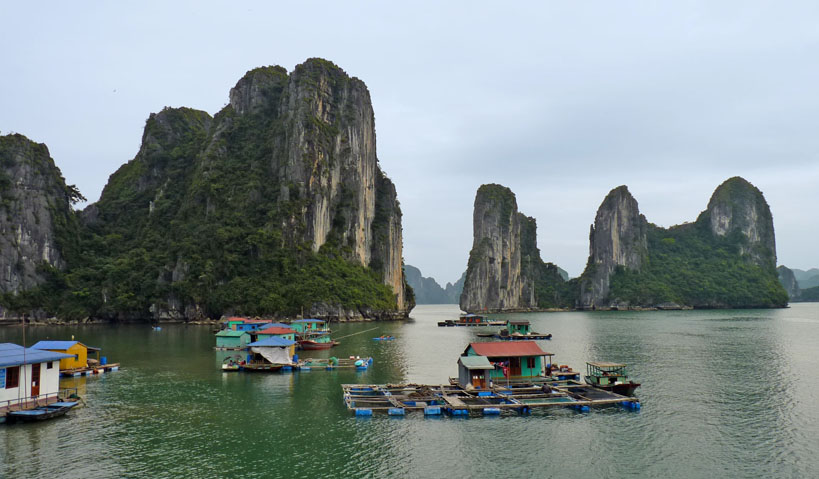
To make a long story short, we do not reach the hotel until well after dark, and it turns out to be a $5/night dive. No way! We walk out and find a nice hotel (a real three star place) on the seafront in Cat Ba town.
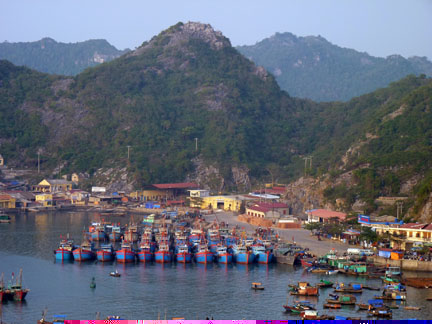

The next day we hire a small boat to take us around the very scenic islets in a part of the bay outside the tourist route. At one we rent bicycles and ride into a small village for lunch. Making lemons out of lemonade.

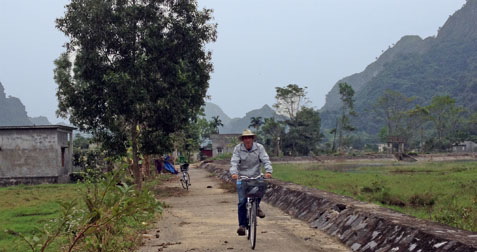
This is my third time in Ha Long, each time in December. The postcard photos you see are taken in the Fall when the weather is clear; this time of year tends to be cloudy, foggy and hazy. Atmospheric, but less than photogenic.

Instead of two nights on a boat we spend two nights in the hotel on Cat Ba. On the last morning, the skies clear for a moment and I get a good shot of Cat Bar harbor and beyond.

A hydrofoil only takes 45 minutes to bring us to Haiphong, from where we catch a bus back to Hanoi. I have booked a sleeper train to Hue, but first stop at the tour company to demand a refund for the undelivered cruise. They knew I was coming, and were so cowed that the girl I booked with was afraid to come in to work: the guy there said the manager told him to man the desk and that when I come in to give me back my money.
The train ride was as expected: the kyup/soft sleeper/4-berth compartment common to soviet-modeled railways. The trip to Hue takes a manageable 14 hours, less than half the time for required for the full ride to Saigon. We arrive mid-morning.


Hue is the former capital. At its heart is a walled complex (2.5 miles around) containing the imperial city. It’s much less grandiose than, say, China’s, and much of it was wrecked in the 1968 Tet offensive. I am surprised that the degree of restoration and reconstruction is not significantly greater than when I was last here fifteen years ago. What hasn’t changed at all is the cosplay photo op. I replicate the identical shot taken in 1997, this time with consort.
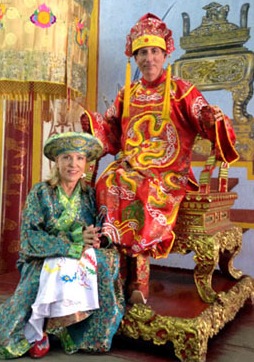

In the nearby environs are clusters of ancient royal tombs. The conventional way to reach them is by boat on the Perfume River or on an organized tour. To be different, we rent a tandem bicycle and pedal out. The excursion ends prematurely by torrential and unceasing rain.
Next stop, Hoi An. It was a charming small town settled by Chinese merchants; now it’s a major tourist destination. A bus takes us from our Hue hotel directly to Hoi An. Boy, has this place grown up! The original core has been pedestrianized and the buildings converted to upscale shops and restaurant. New construction to accommodate the tourist hordes surrounds: on the streambank opposite is a parallel fake town cum shopping mall.


Though touristic, Hoi An is still photogenic.
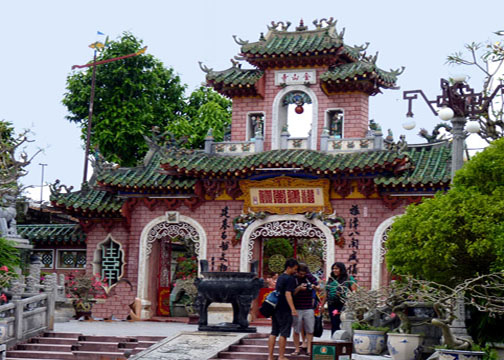

 |
 |
We take a day room to allow a freshen-up before our late-evening flight to Saigon.
Saigon is the showcase of modern Vietnam. Modern skyscrapers and glitzy malls complement the restored French-built landmarks such as the post office, cathedral, opera house, and city hall. New hotels open daily. There is much new infrastructure, but traffic has grown commensurately. This is the city of a million motorbikes (actually, the current estimate is closer to four million). And, by the way, although Saigon was renamed Ho Chi Minh City in 1975, nobody calls it that.

This is my third time here, so this is all repeat stuff.
 |
 |
| post office | interior ironwork by Gustav Eiffel |
|
|
|
| opera house | Uncle Ho in front of City Hall |
A day trip to Tay Ninh and the Cao Dai temple and the by now very tired Cu Chi tunnels.




Another day trip to the Mekong Delta.

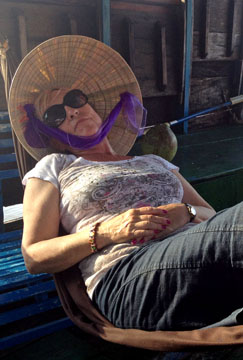


Also accomplished, lots of shopping.
Our last night is New Year’s Eve, which is a street party for millions (literally), who cram into the central district for concerts, laser shows, and fireworks. Early morning New Year’s Day is our first of several flights homeward, which, through the magic of the International Date Line, are completed before the sun sets.












